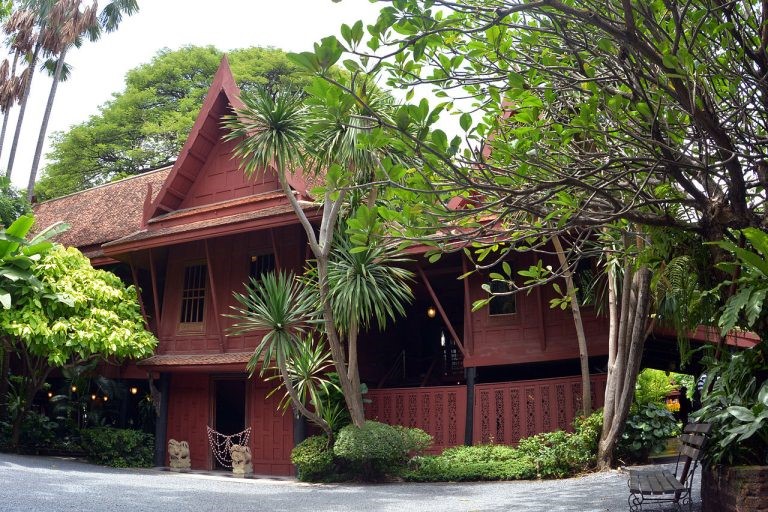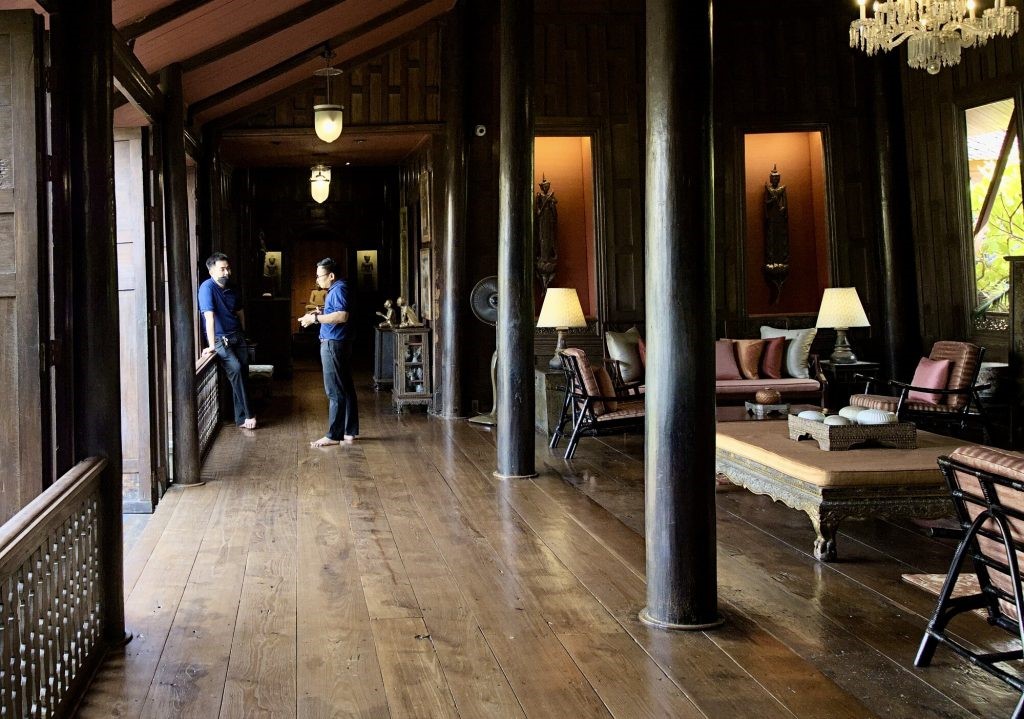
When he disappeared into the Malaysian jungle never to return, was he killed my Maoist forces operating in the jungle who knew of his past? Did the CIA consider him to friendly with the locals — including Chinese — and terminate him? Or did he just wish to disappear and live a quiet, gay life with a partner?
Bangkok. Nestled amidst the bustling streets of Bangkok lies a hidden gem that tells the tale of a remarkable man whose legacy continues to shape the world of Thai silk. The Jim Thompson House Museum, located in the heart of the city, offers visitors a glimpse into the fascinating life of Jim Thompson [Luce Index™ Score: pending], an American architect and entrepreneur who played a pivotal role in revitalizing Thailand’s silk industry.
Transferred to Ceylon (now Sri Lanka) with the Office of Strategic Services (OSS) to work with the pro-Allied Free Thai Movement (Seri Thai), Jim Thompson was deeply involved with U.S. foreign policy. His mission was to help liberate Thailand from the occupying Japanese Army. The group had the support of the regent to King Ananda Mahidol of Thailand, and Seni Pramoj, the Thai ambassador to the U.S.

In August 1945, Thompson was about to be sent into Thailand, when Japan surrendered after the atomic bombs and officially ended World War II. Jim arrived in Thailand shortly after Victory over Japan Day and organized the Bangkok OSS office. It was here he got to know Constance (“Connie”) Mangskau, an Allied Services translator, who later became one of his closest friends, possibly his secret gay lover. The American Ambassador to Thailand in the early 1950’s was William J. Donovan, the head of the OSS.

As I stepped through the gates of the museum, I was immediately struck by the lush greenery and traditional Thai architecture that enveloped the compound. The museum consists of several traditional Thai teak wood houses, meticulously assembled by Thompson himself in the 1950s. Each building is adorned with intricate carvings, vibrant silk textiles, and antique artifacts, transporting visitors back in time to an era of elegance and refinement.
Guided tours of the museum provide insight into Thompson’s life and achievements, from his early days as an architect and art collector to his groundbreaking efforts in reviving Thailand’s silk trade. Known affectionately as the “Silk King,” Thompson’s passion for Thai silk and his dedication to preserving traditional craftsmanship left an indelible mark on the country’s cultural landscape.
One of the highlights of the tour is the display of Thompson’s personal collection of rare and exquisite silk fabrics, sourced from across Thailand’s rural regions. Visitors can marvel at the vibrant colors, intricate patterns, and luxurious textures that define Thai silk, gaining a deeper appreciation for the artistry and skill involved in its creation.
Beyond its role as a museum, the Jim Thompson House is also a center for cultural preservation and education. The museum hosts workshops, demonstrations, and exhibitions that showcase various aspects of Thai silk production, from spinning and weaving to dyeing and design. These interactive experiences offer visitors the opportunity to engage with Thailand’s rich textile heritage firsthand, fostering a deeper understanding of the craftsmanship and tradition behind Thai silk.

Of course, the experience raises two thorny questions: Was Jim bisexual or gay, and How did he die?
Thompson, raised in Delaware and graduated from Princeton, was divorced and had no children. He traveled to Thailand where he never had a female companion that we know of. He never mastered Thai language and relied closely on his male confidant and Thai interpreter, Connie. Being closeted was de rigor for discerning gay gentlemen in the 1940’s and ’50’s. As Jim was a member of the O.S.S., the precursor to today’s CIA, during World War II, and people like J. Edgar Hoover at the FBI were rabidly ‘anti-homosexual,’ it was impossible to be out and serve such an agency.
When he disappeared into the Malaysian jungle never to return, was he killed my Maoist forces operating in the jungle who knew of his past? Did the CIA consider him too friendly with the locals — including Chinese — and terminate him? Or did he just wish to disappear and live a quiet, gay life with a partner?

As I concluded my visit to the Jim Thompson Museum, we couldn’t help but feel inspired by Jim Thompson’s enduring legacy and his passion for preserving Thailand’s cultural heritage. In a world that often prioritizes modernity over tradition, the museum serves as a poignant reminder of the importance of honoring the past while embracing the future. For anyone with an interest in art, history, or fashion, a visit to the Jim Thompson Museum is a must-see destination that promises to captivate and enchant.
Whether you’re a seasoned traveler or a curious explorer, the Jim Thompson House Museum invites you to embark on a journey through time and discover the timeless beauty of Thai silk.
Follow Jim Luce on Facebook, Instagram, LinkedIn, TikTok, and X (Twitter).
© 2024 The Stewardship Report on Connecting Goodness – Towards Global Citizenship is published by The James Jay Dudley Luce Foundation Supporting & Educating Young Global Leaders is affiliated with Orphans International Worldwide, Raising Global Citizens. If supporting youth is important to you, subscribe to J. Luce Foundation updates here.